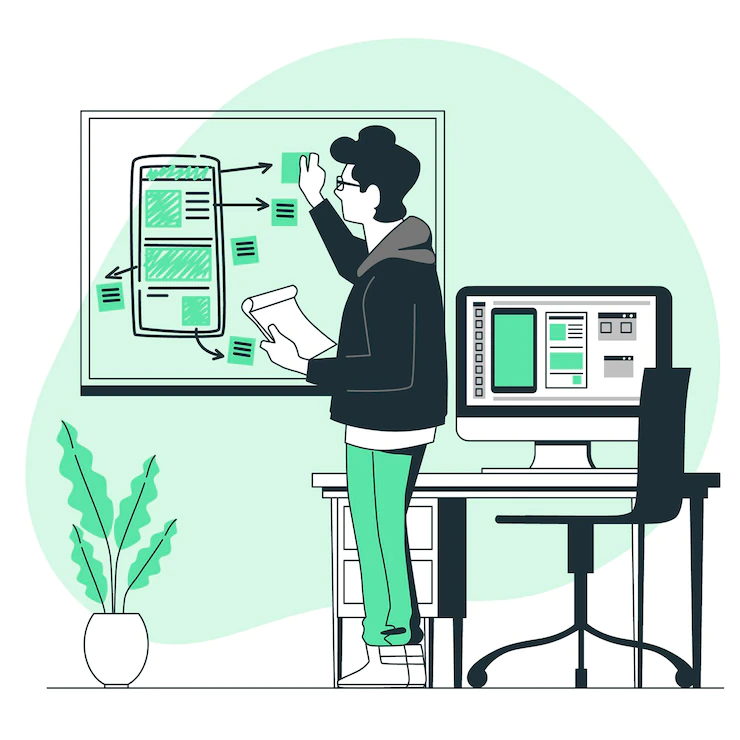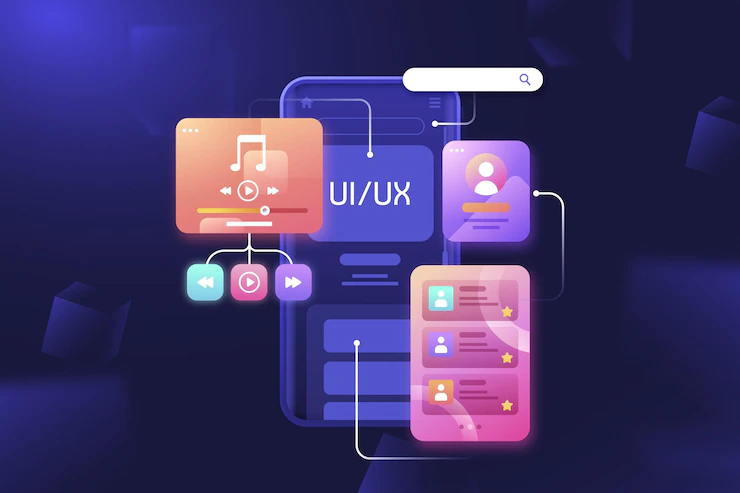UI UX Design
We interact with several digital products every day. They enhance our user experiences and enable us to handle complex workflows at the tap of a finger or a button. Digital products, including mobile apps, web apps and desktop applications, all bear unique appearances and functionalities. It is almost impossible to mention digital products without mentioning UI UX design. These terms are two sides of the same coin. That fancy digital app will only work when the user interface (UI) complements user experiences (UX). Stoke Ventures specializes in UI UX design on behalf of individuals and businesses. So let’s explore what’s involved with high quality UI UX design, and how we approach it at Stoke Ventures.

UI UX design is vital for developing several digital products
What is UI Design
The physical appearance of any digital product results from tireless work by the user interface design teams. The designer handles the aesthetic value of the product. That is the look, the appeal and the graphical layout of the digital product. The essence of all the appealing layouts is ensuring the app is functional and the end user can easily navigate or locate commands with ease. Think of sliding your finger to the side on your phone to access the next or previous web page, deleting a data entry through a single tap on the screen or merging multiple files by clicking on a command button.
UI design optimizes the fine details of an application. The designers cater to everything regarding color combinations, button types, relevant imagery, background animations, size and organization of graphics on the interface.

UI Design Focuses On Appearance and Feel Of Applications
UI affects how the target or end users interact with machines. It implies the discipline is not limited to handheld devices or computers only. Industrial designers engage UI designers when developing automation solutions for complex production facilities and ensure the monitoring interfaces or control panels contain commands for executing different commands.
Your interaction with this article is made possible using excellent UI design. The typical user interface comprises hardware for inputting data and outputting required information. Input and hardware devices work in unison to enable users to control machines, applications and web services.
Executing a functional user interface can be achieved using different formats. Some applications allow utilizing more than one format to perform specific tasks. The formats include:
- Graphic User Interface
- Command Line Interface
- Voice-Based Interface
- Gesture-Based Interface
Command Line Interface
Command line interfaces were popular in the early ages of computing. Command lines are fairly old technology that gave birth to modern user interfaces. When using these interfaces, the user supplied commands to the machine. In return, the machine prints out a message or displays a message on the display screen. The systems used machine language and had limited functionalities. Therefore, each computer performed a specific task and responded to a particular set of commands. The quality of human-machine interactions was a bit complex.
Voice-Based Interface
Voice-based user interfaces are designed to overcome the shortcomings of graphic user interfaces. For instance, the user needs to undertake prior training to understand how the different elements of the GUI operate. When using voice-based interfaces, the user interacts with digital systems using their voices. Voice-based UI is considered a Zero interface technology. The digital devices respond to human voices to perform some tasks. One popular voice-based UI is Amazon’s Alexa. Through this service, users can command mobile phones to make a call, play music, and record a video, among other activities.
Modern voice-based interfaces are AI-enabled. It implies that digital systems have advanced voice processing capabilities and can process different human languages.
Graphic User Interface
In Graphic User Interface (GUI) design, user interactions are made possible using diverse visual elements. The graphic user interface may contain several digital buttons and static or active elements that enable users to navigate app sections, web pages or application screens. The interactive controls allow users to input different controls and respond by providing the desired output.
The introduction of graphic user interfaces was revolutionary as it enabled more people to use computers. The interactive user interfaces meant anyone could use the computer to enhance productivity even if they had little or no coding skills.
Most digital products have graphic user interfaces. GUI is flexible and can be designed for handheld and desktop devices.
Gesture-Based Interfaces
Recently, businesses and individuals are using virtual reality for productivity, training and entertainment. These systems are interactive, and rely on 3D imagery and videos to describe scenarios. These systems respond to physical user gestures to transition between pages or virtual scenarios. They monitor user emotions and adjust factors like lighting and sound intensity to satisfy user preferences.
What Defines A Great User Interface?
User interfaces are not equal. The quality of user interfaces depends on the creativity of the UI designer, level of user research and choice of design tools. Although we have several UI design formats, they have similar desirable characteristics. A well-designed user interface should be:
- Clear – The contents of the user interface must be clear for the end user. The interactive buttons must be visible and well-organized.
- Consistent- Some interfaces are designed for use across different devices. For instance, the UI for mobile applications should have similar functionality and optimized appearance when used in different phone models. The same should apply when installed on iOS or Android systems.
- Efficient – The user should not struggle to navigate the digital product. The end-user must achieve the desired output using the fewest inputs. Technically, the user should achieve maximum productivity with the least effort.
- Familiar – User interfaces must be simple yet effective. The end-user should leverage previous user experiences to manipulate digital products.
Roles of UI Designers
UI designers are responsible for optimizing the appearance and attractiveness of digital products. They also enhance the responsiveness and interactivity of mobile apps, web pages and other digital products. Therefore, UI designers perform one or a combination of the following activities.
Product research
Before developing a digital product, designers must research consumer behaviors. They should understand consumer pain points, past experiences using similar products, and their preferences for new products. The designer should also explore current market trends.
What tools are their competitors using to design new products? Which are the popular UI design trends? Which design gaps exist in the market?
The designer then leverages research data to develop a prototype and create a plan for creating better UI designs.
Visual design
With the correct data at hand, the designer proceeds to select the most appealing visual designs. They try to match user expectations by tweaking product colors, selecting unique fonts, organizing different commands across the layout and using the most effective interactive buttons.
Product branding and graphic design
The final product should perform its intended purpose and facilitate brand awareness for new users. The UI designer complements the marketing activities by using optimized brand images or logos without interrupting the functionality and ease of navigation for software products.
Prototyping
The UI designer creates functional prototypes to showcase how the end product looks and feels. The designer releases the prototype to a select team of testers who evaluate the quality of the UI, functionality and responsiveness. The design team may need to develop several prototypes and incorporate feedback from the testers before developing and releasing the final product.
Animation, responsiveness and interactive design
The final UI design must be compatible with different devices. Different visual, voice or command line features should be responsive to user inputs. The designer may participate in graphic design and create animations that are used for marketing and educational purposes to showcase how digital products operate.
What is UX Design
What does the user feel when interacting with digital products? Do they gain value from the products? User experience (UX) design deals with all activities focusing on the usability and functionality of end products. UX designers immerse themselves in the user environments and visualize how the digital products affect their productivity. They create a user journey by empathizing with the end users and facilitating the conversion of user problems into functional solutions.
UX designers must understand the depth of user problems and devise ways to solve the problems using user-centered product designs. The designer’s journey begins with identifying a user need and defining project goals and ends with the development of a wireframe or functional prototypes.
UX Design deals with the functionality of digital products
UX designers are advocates who figure out how and why the user needs a particular product. Often, the user faces challenges when executing certain tasks. Such challenges enable them to create a brief problem statement. Once the UX designer analyzes these needs, they figure out how an application or website can lessen workflow problems.
UX designers place significant focus on the end user. Their goal is to ensure products are useful, understandable and easy to use. How do designers ensure they deliver delightful products from abstract ideas and concepts?
Creating a user-friendly digital product requires the design of an elaborate user journey. The designer creates a product-specific user journey and user personas that enable them to visualize product functionality in different environments. The user personas are crucial for characterizing multiple user behaviors. The designer can create products that solve predominant challenges affecting different target markets.
User journeys and personas can unearth multiple product limitations and help designers to prioritize and implement different product concepts and ideas.
Roles of UX Designers
UX designers define user flows and develop systems that guarantee optimum satisfaction among the end users. They create products that solve complex problems effortlessly. The designer manages every aspect of product development and conducts extensive research at every stage. They also test the products before releasing them to the public as a minimum viable product (MVP) or a functional prototype. The scope of a UX designer spans:
- Research and development
- Design, coding and prototyping
Research and Development
UX design is user-centric. The designer must empathize with the end-user to develop the most suitable product alternative. A bulk of the pre-design activities involve user research to answer questions about product viability, shortcomings of existing or similar products, and establishing an action plan to facilitate the conversion of ideas to digital products.
Initial development activities involve conceptual product designs and defining information architecture. It enables the development team to correctly label the contents of the final product, create project implementation timelines and milestones, and define specific goals for the entire project.
Design, coding and prototyping
The bulk of UX design work falls in this category. The designer researches to collect data regarding specific user needs. They leverage the data to develop user flows and begin actualizing the appearance, functionality and reliability of the end product.
Different designers use unique approaches to meet project objectives. Some will initiate the coding process with a functional prototype in mind. Other teams prefer developing a wireframe, a representative interface, to showcase how the end-product appears and operates.
The next stage involves testing the wireframe or prototype against the initially developed project goals. The designer seeks to validate if the proposed product concept works and addresses existing user needs. At the prototyping stage, the designer confirms if their product concepts are actionable. At the end of the process, the designers analyze the success rates of the project and leverage available data to define the next steps of action.
Characteristics of A Good UX Design
A perfect UX design should be:
- Functional
- Reliable
- Usable
- Pleasurable
The user should gain maximum value from the product and find pleasure when utilizing these products to manage routine workflows and enhance daily interactions with humans and machinery.
Differences Between UI and UX Design
Now that we understand what UI UX design entails, we dig deeper to explore if these terms are different. UI UX designers must work together to deliver quality digital products. Experts from both fields leverage their skills to ensure the end-user has an easy time interacting with the products or services of a particular company. The principal difference in UI UX design is how the experts approach problem-solving.

UI and UX Design are used to achieve common design goals
The purpose of UX design is to develop functional products and aims to optimize entire user journeys and experiences. UI design focuses on the feel and appearance of the product once the reported user need has been solved. The designers also use different tools to achieve their goals. For instance, UI designers use tools like InVision, Photoshop or Figma to create visually appealing interfaces. The designers require basic knowledge of Frontend programming languages, including Javascript, CSS or HTML5. Developers can complete some design tasks using a specialized UI designer app. On the other hand, UX designers use digital tools like Adobe Creative Suite or Axure. They require strong coding skills and should be acquainted with one or more Backend Programming languages.
Benefits of Collaborative UI UX Design
UI UX design is a collaborative process that brings together teams with different skills to work on a common product. When the teams work together, they can easily combat arising design challenges. These experts leverage past experiences to streamline product development activities. Stoke Ventures has established structures to facilitate collaborative UI UX design of different software products.
UI UX design teams can tweak conceptual products severally. Those working on the feel and appearance of the product can propose additional changes, commands or features and design the accompanying control buttons.
Maintaining constant collaboration and communication between UI UX design teams reduces the time required to develop and launch new digital products. Users can easily identify well-designed digital products by evaluating their visual appearances and flow of commands.
Shortcomings of Combining UI UX Design
Combining UI UX design is beneficial if you enlist specialized skilled experts to handle product development. However, you may come across a UI UX design agency that deals with desktop, software or mobile app UI UX design with a small team with basic knowledge of both fields. The lean team can deliver small-scale projects that do not require extensive user research or have few design features.
It is vital to specify UI UX design roles when handling different projects. Over time, designers develop strong problem-solving, research and prototyping skills. Combining UI UX roles can be detrimental for particular design projects. Designers end up spending more time switching between idea conceptualization and implementation. It can limit the team’s creativity, and some designers may fail to pay close attention to fine details. They end up developing unreliable, poorly functioning products.
The best way to overcome combined UI UX design challenges is to offer the design teams the freedom to explore agile development methodologies independently and establish robust channels to facilitate collaborations between experts.
UI UX Design and Research
Comprehensive research is part and parcel of UI UX design. Often, designers combine information from different sources to expedite the development process and ensure user needs are addressed fully. The designers require sufficient information about what the users want, existing and emerging market trends, market penetration and retention strategies and predominant user behaviors.
While research remains an integral part of UI UX design, the approaches used by UI designers vary from those used by UX designers. However, their goals are similar – making user experiences as enjoyable as possible. Research also enables our teams at Stoke Ventures to overcome design hurdles and make major decisions regarding the direction and progress of different projects.

UI UX designers require basic coding skills
UX UI design teams must ensure they tackle real problems and that their proposed solutions are relevant. With the right data, the design team can dedicate their effort to developing functional products. These teams can gather information using different research methods. UX designers collect user data using:
- Structured user interviews
- Surveys
- One-on-one engagement with focus groups
- Developing user personas
Learning UI UX Design
Perhaps UI UX design sounds complex and a profession reserved for a few individuals. However, anyone can venture into the field and make a living developing different digital products for a diversified customer base. Anyone with a passion for UI UX design and user-centric product development can acquire the relevant technical skills to enable them to handle any kind of digital product development.
There are several ways to acquire the requisite skills before joining a reputable UI UX design agency or serving clients as a freelance designer. Here is a look at the different options to acquire and strengthen UI UX design skills.
The dilemma for individuals venturing into digital product development is whether they should specialize in UI or UX design. It becomes more confusing when companies advertise combined UI UX roles. However, this should not be a cause of concern. Individuals need to evaluate their strengths and skill sets. Do you like building complex information architecture? Do you prefer building user flows, or are you interested in visual product designs?
Understanding your capabilities enables you to make decisions on what courses to study. It is advisable to gain sufficient skills in both fields. An all-rounded individual has better chances at a job since they can contribute to both aspects of digital product development.
Additionally, individuals possessing both UI and UX design skills receive better compensation. Later in your career, it may be vital to specialize in a particular niche or role, say a mobile UI designer.
Self-learning
Technology has enabled individuals to acquire technical skills through the internet. Institutions and expert trainers provide tutorials, learning materials and resources that are accessible for free or at a fee. Self-learning UI UX design demands the highest discipline levels and sufficient time to learn and practice different concepts.
Learning UI UX design through self-learning enables individuals to pace their studies to suit their work schedules.
Attending Bootcamps
Bootcamps are a great way for individuals to gain UI UX design skills. These are fast-paced learning initiatives and programs which run for a few months, sometimes weeks depending on the learner’s skill levels. Learners undergo intense training and participate in several competitions to quantify their skills after specific timelines. Learners can attend physical and online Bootcamps depending on their preferences.
Bootcamps are beneficial since they combine independent and guided learning, enabling them to grasp different concepts of UI UX design. In some Bootcamps, learners also receive coaching from experts. Upon completing the boot camp, the learner can create a portfolio to enable them to land the first UI UX design job.
Learning UI UX design in a Bootcamp can be a little challenging since the learning period is short, and individuals spend considerable sums of money for placement at these Bootcamps.
Studying in an accredited college
Individuals can kickstart their careers in UI UX design by attending a college offering courses biased towards product development, human-centered design software development or software engineering. Learners can choose from a wide variety of courses and select a specialization of their choice. A college degree often takes a few years to complete, and learners can explore different design tools. They also participate in diverse supervised projects to gauge their skills.
Some college degrees can be too broad, and learners may not enjoy one-on-one career coaching, which is popular in UI UX design Bootcamps.
UI UX Design Jobs and Salaries
A career in UI UX design is attractive and viable for anyone with a creative knack and a great eye for detail. In the digital age, companies, businesses and individuals are continually exploring ways to enhance user experiences and delight the customers they are serving. Every day, UI UX design teams receive requests to work on new and product improvement projects.
UI UX design is relevant today and in the future, because more businesses are shifting their operations to the digital space. It is becoming almost impossible for people to conduct business without using mobile phones or other computerized devices. It implies that the demand for digital solutions is not ending soon.
- UI UX design roles are good because:
- There is high demand for skilled UI UX design teams.
- UI UX design agencies offer attractive salaries.
- UI UX design is a continuous learning path, and designers acquire new technical and soft skills when implementing different projects.
- UI UX design is a creative process that improves communication and research skills.
UI UX design teams receive varying compensations depending on their experience levels and the complexity of the projects they handle. The salary scales provided here are estimated figures sourced from online resources. It implies that some UI UX designers receive more or less than the stated figures.
Entry-level UI UX designers in the US earn up to $77,108 annually. This figure is inclusive of bonuses and overtime compensation. Some sites put the monetary compensation of junior-level UI UX designers at slightly more than $61000 annually. Experienced UX designers earn up to $113,109 annually, while UI designers pocket an average of $96,000 yearly.
Final Words
UI and UX design are complementary fields that facilitate the development of innovative and futuristic digital products. They leverage data to identify user needs, optimize ideation and conceptualization and ensure final products provide real value to the end users. UI UX design helps companies develop cutting-edge technologies and solve several complex problems by combining creativity and multiple design tools.
The differences between UI and UX design make product design enjoyable. Experts from these fields combine their skills to achieve a common goal. We now understand how UI UX design works, it is time to bring your ideas to life. Anyone can also enroll in a course in UI UX design and begin a career in the field.
At Stoke Ventures, we are open for business and are ready to help our clients to develop revolutionary products using the best industry practices.

